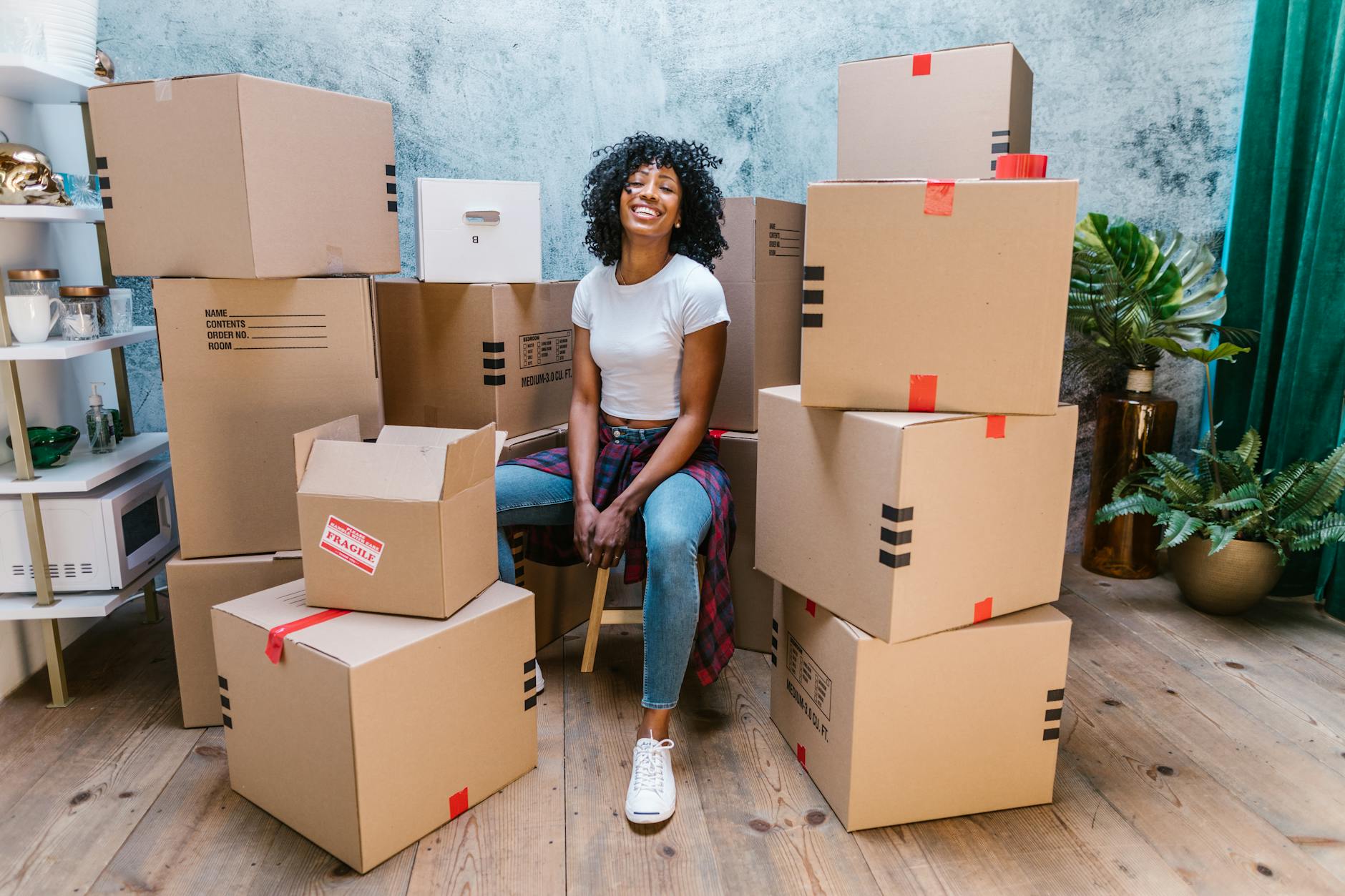Packing Hacks for Stress-Free Moving
Moving can be exciting yet stressful, especially when it comes to packing up your entire household. But fear not, dear reader, for I have some nifty packing hacks up my sleeve that will make your moving experience a breeze!

1. Start Early, Pack Smart You’ve probably heard this before, but it’s worth repeating: start packing as early as possible. Don’t wait until the last minute, or you’ll end up in a frenzy. Begin with non-essential items like seasonal clothes or decorations. Pack room by room, labeling boxes clearly to avoid confusion later.
2. Use What You Have Don’t rush to buy packing supplies. Utilize items you already have, like suitcases, laundry baskets, and storage bins. They’re perfect for transporting clothes, linens, and other bulky items. Get creative with blankets or towels to cushion fragile items instead of buying bubble wrap.
3. Declutter and Donate Moving is the perfect opportunity to declutter your home. Sort through your belongings and donate or sell what you no longer need. Not only does this lighten your load, but it also makes packing and unpacking much easier. Plus, you’ll feel good about giving back to the community.
4. Pack Strategically Think strategically when packing your boxes. Place heavy items at the bottom and lighter ones on top to prevent crushing. Fill empty spaces with soft items like clothing or towels to minimize shifting during transit. Use small boxes for heavy items like books to avoid back strain.
5. Label Everything Labeling is key to staying organized during a move. Clearly label each box with its contents and the room it belongs to. This makes unpacking a breeze and ensures that boxes end up in the right place. Color-coded labels can also help distinguish between rooms at a glance.
6. Essential Box Create an “Essentials Box” filled with items you’ll need immediately upon arrival. Include toiletries, a change of clothes, important documents, and basic kitchen supplies. Keep this box with you during the move so you can access these essentials without unpacking everything right away.
7. Wrap Breakables Carefully For fragile items like glassware and dishes, use soft materials like packing paper, towels, or clothing to cushion them. Wrap each item individually and pack them snugly in boxes. Clearly mark these boxes as fragile and handle them with care during the move.
8. Seal and Secure Once you’ve packed a box, seal it securely with strong packing tape. Reinforce the bottom of the box with extra tape for added durability. Avoid overpacking boxes, as they may burst open during transit. Use straps or ropes to secure larger items like furniture or appliances.
9. Take Inventory Keep track of your belongings by creating a detailed inventory list. Note down each box’s contents and its corresponding room. This will help you stay organized during packing, unpacking, and settling into your new home. It’s also useful for insurance purposes in case of loss or damage.
10. Stay Calm and Stay Hydrated Moving can be hectic, but remember to take breaks, stay hydrated, and take care of yourself. Delegate tasks to family members or friends to lighten the load. Keep a positive attitude and focus on the exciting new chapter awaiting you in your new home.

Organizing Your Move Timeline and Checklist
Moving can be overwhelming, but with a well-organized timeline and checklist, you can stay on top of things and make the process smoother. Here’s how to create a stress-free move timeline and checklist that works for you.
1. Assess Your Moving Needs The first step in organizing your move is to assess your needs. Determine your moving date, the size of your home, and the amount of stuff you need to move. This will help you create a realistic timeline and checklist tailored to your specific requirements.
2. Create a Timeline Once you have an idea of your moving needs, create a detailed timeline leading up to the moving day. Start with tasks that need to be done weeks or months in advance, such as decluttering, researching moving companies, and notifying utilities. Break down larger tasks into smaller, manageable steps to stay organized.
3. Make a Checklist A comprehensive checklist is your best friend during a move. List down all the tasks you need to complete, including packing, changing addresses, scheduling movers, and transferring utilities. Organize your checklist by priority and deadline to stay focused and on track.
4. Declutter and Organize Before you start packing, take the time to declutter and organize your belongings. Donate or sell items you no longer need or use. Sort your belongings into categories and label boxes accordingly. This will make packing and unpacking much easier and help you save time and space.
5. Pack Strategically When packing, be strategic about how you organize your boxes. Pack similar items together and label each box with its contents and destination room. Use sturdy boxes, packing materials, and tape to ensure your belongings stay safe during transit. Don’t forget to pack essentials separately for easy access upon arrival.
6. Notify Utilities and Services A few weeks before your move, notify utilities, services, and subscriptions of your change of address. This includes electricity, water, internet, cable, mail forwarding, and any other services you use regularly. Update your address with banks, insurance providers, and government agencies as well.
7. Schedule Movers or Rent a Truck If you’re hiring movers or renting a truck, schedule them well in advance to secure your preferred date and time. Research moving companies, read reviews, and get quotes to find the best option for your budget and needs. Confirm all details and arrangements a few days before the move.
8. Pack an Essentials Box Prepare an essentials box containing items you’ll need immediately upon arrival at your new home. Include toiletries, a change of clothes, important documents, snacks, and any other necessities. Keep this box with you during the move for easy access and peace of mind.
9. Confirm Details and Double-Check As moving day approaches, confirm all details with your movers or rental company. Double-check your timeline and checklist to ensure you haven’t missed anything. Take photos of important documents and valuables for reference. And most importantly, stay positive and organized throughout the process.
Choosing the Right Moving Company
Moving can be an adventure, but choosing the right moving company can make all the difference. With so many options out there, it’s important to find a reliable and trustworthy partner to help you navigate this exciting journey. Here are some tips to help you choose the perfect moving company for your needs.
1. Do Your Research When it comes to finding the right moving company, research is your best friend. Start by checking online reviews and ratings to get an idea of other customers’ experiences. Look for companies with a good track record of reliability, professionalism, and customer satisfaction.
2. Get Multiple Quotes Don’t settle for the first moving company you come across. Get quotes from multiple companies to compare prices and services. Be wary of unusually low prices, as they may indicate subpar service or hidden fees. Choose a company that offers transparent pricing and clear communication.

Settling into Your New Home: Unpacking Strategies
Congratulations on your new home! Now comes the fun part: unpacking and settling in. Here are some strategies to make the process smooth and enjoyable.
1. Start with Essentials Begin unpacking with essentials like bedding, toiletries, and kitchen items. This way, you’ll have what you need for the first few days without feeling overwhelmed by unpacking everything at once.
2. Room by Room Approach Take a room-by-room approach to unpacking. Start with the most-used areas like the bedroom, kitchen, and bathroom. Then move on to less essential rooms like the guest bedroom or home office.
3. Use the 3-Box Method The 3-box method is a game-changer for unpacking. Label three boxes as “keep,” “donate/sell,” and “discard.” As you unpack, place items in the appropriate box to declutter and organize simultaneously.
4. Create Zones Designate specific zones for different purposes in each room. For example, in the kitchen, create zones for cooking, food storage, and cleaning supplies. This organization makes finding items easier and keeps your home functional.
5. Use Vertical Space Maximize vertical space in closets and cabinets by using shelving units, hanging organizers, and hooks. This helps to store more items efficiently and keeps your spaces clutter-free.
6. Unpack Strategically Unpack strategically by considering your daily routine. Keep frequently used items easily accessible and store seasonal or occasional items in less accessible areas.
7. Prioritize Comfort Focus on creating a comfortable and cozy atmosphere in your new home. Unpack bedding, curtains, and decor items that make your space feel like home.
8. Take Breaks Unpacking can be tiring, so remember to take breaks. Stay hydrated, snack on energizing foods, and don’t push yourself too hard. Pace yourself to avoid burnout.
9. Personalize Your Space Add personal touches to your new home by displaying photos, artwork, and sentimental items. These little touches make your space uniquely yours and bring warmth to the environment.
10. Celebrate Progress Celebrate small wins as you unpack and settle in. Whether it’s completing a room or finding the perfect spot for a decor piece, acknowledge your progress and enjoy the journey.
11. Get to Know Your Neighborhood As you settle into your new home, take the time to explore your neighborhood. Discover local shops, parks, and amenities to feel more connected to your new community.
12. Reach Out for Support Don’t hesitate to ask for help if you need it. Friends, family, or professional organizers can lend a hand and make the unpacking process more enjoyable.

